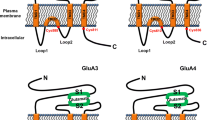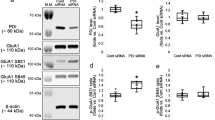Abstract
Sulfhydryl compounds such as dithiothreitol (DTT) and β-mercaptoethanol (β-ME) are widely used as redox agents. Previous studies in our group and other laboratory have reported the effect of sulfhydryl compounds on the function of glutamate receptor, including plasticity. Most of these findings have focused on the N-methyl-d-aspartic acid receptor, in contrast, very little is known about the effect of sulfhydryl compounds on α-amino-3-hydroxy-5-methylisoxazole-4-propionic acid receptor (AMPAR). Here, we observed that DTT (100 μM), β-ME (200 μM) and l-cysteine (200 μM) significantly elevated the surface expression of AMPARs via reducing their palmitoylation in rat hippocampal slices in vitro. Increased surface stability of AMPARs was not be correlated with the altered redox status, because the chemical entities containing mercapto group such as penicillamine (200 μM) and 2-mercapto-1-methylimidazole (200 μM) exhibited little effects on the surface expression of AMPARs. Computing results of Asp-His-His-Cys (DHHC) 3, the main enzyme for palmitoylation of AMPARs, indicated that only the alkyl mercaptans with chain-like configuration, such as DTT and β-ME, can enter the pocket of DHHC3 and disrupt the catalytic activity via inhibiting DHHC3 auto-palmitoylation. Collectively, our findings indicate a novel redox-independent mechanism underlay the multiple effects of thiol reductants on synaptic function.









Similar content being viewed by others
Abbreviations
- ABE:
-
Acyl-biotin exchange
- ACSF:
-
Artificial cerebrospinal fluid
- AMPAR:
-
α-Amino-3-hydroxy-5-methylisoxazole-4-propionic acid receptor
- APV:
-
dl-2-amino-5-phosphonopentanoic acid
- β-ME:
-
β-Mercaptoethanol
- BS3 :
-
Bis (sulfosuccinymidal) suberate
- CNS:
-
Central nervous system
- CRD:
-
Cysteine-rich domain
- DHHC:
-
Asp-His-His-Cys
- DTT:
-
Dithiothreitol
- HRP:
-
Horseradish peroxidase
- LTP:
-
Long-term potentiation
- MMTS:
-
Methylmethanethiosulfonate
- NAC:
-
N-acetyl cysteine
- NMDAR:
-
N-methyl-d-aspartic acid receptor
- PATs:
-
Palmitoyl acyl transferases
- PPTs:
-
Palmitoyl protein thioesterases
- TTX:
-
Tetrodotoxin
References
Deneke SM (2000) Thiol-based antioxidants. Curr Top Cell Regul 36:151–180
Kr zel A, Lesniak W, Jezowska-Bojczuk M, Mlynarz P, Brasun J, Kozlowski H, Bal W (2001) Coordination of heavy metals by dithiothreitol, a commonly used thiol group protectant. J Inorg Biochem 84:77–88
Cho JH, Askwith CC (2007) Potentiation of acid-sensing ion channels by sulfhydryl compounds. Am J Physiol Cell Physiol 292:C2161–C2174
Amato A, Connolly CN, Moss SJ, Smart TG (1999) Modulation of neuronal and recombinant GABAA receptors by redox reagents. J Physiol 517(Pt 1):35–50
Ullian ME, Beck CN, Walker LP, Fitzgibbon WR, Morinelli TA (2009) Thiol antioxidants regulate angiotensin II AT1 and arginine vasopressin V1 receptor functions differently in vascular smooth muscle cells. Am J Hypertens 22:221–227
Arakawa M, Ito Y (2007) N-Acetylcysteine and neurodegenerative diseases: basic and clinical pharmacology. Cerebellum 6:308–314
Pocernich CB, Butterfield DA (2012) Elevation of glutathione as a therapeutic strategy in Alzheimer disease. Biochim Biophys Acta 1822:625–630
Aizenman E, Lipton SA, Loring RH (1989) Selective modulation of NMDA responses by reduction and oxidation. Neuron 2:1257–1263
Pan ZH, Bahring R, Grantyn R, Lipton SA (1995) Differential modulation by sulfhydryl redox agents and glutathione of GABA- and glycine-evoked currents in rat retinal ganglion cells. J Neurosci 15:1384–1391
Lipton SA, Choi YB, Pan ZH, Lei SZ, Chen HS, Sucher NJ, Loscalzo J, Singel DJ, Stamler JS (1993) A redox-based mechanism for the neuroprotective and neurodestructive effects of nitric oxide and related nitroso-compounds. Nature 364:626–632
Sucher NJ, Lipton SA (1991) Redox modulatory site of the NMDA receptor-channel complex: regulation by oxidized glutathione. J Neurosci Res 30:582–591
Cai F, Wang F, Lin FK, Liu C, Ma LQ, Liu J, Wu WN, Wang W, Wang JH, Chen JG (2008) Redox modulation of long-term potentiation in the hippocampus via regulation of the glycogen synthase kinase-3beta pathway. Free Radic Biol Med 45:964–970
Yang J, Hu ZL, Jiang B, Ni L, Jin Y, Chen JG, Wang F (2011) Effect of chloramine-T on long-term potentiation at synapses between perforant path and dentate gyrus in hippocampus of rats in vivo. Neurotoxicology 32:199–205
Bodhinathan K, Kumar A, Foster TC (2010) Intracellular redox state alters NMDA receptor response during aging through Ca2+/calmodulin-dependent protein kinase II. J Neurosci 30:1914–1924
Yang YJ, Wu PF, Long LH, Yu DF, Wu WN, Hu ZL, Fu H, Xie N, Jin Y, Ni L, Wang JZ, Wang F, Chen JG (2010) Reversal of aging-associated hippocampal synaptic plasticity deficits by reductants via regulation of thiol redox and NMDA receptor function. Aging Cell 9:709–721
Wang Y, Guan XL, Wu PF, Wang CM, Cao H, Li L, Guo XJ, Wang F, Xie N, Jiang FC, Chen JG (2012) Multifunctional mercapto-tacrine derivatives for treatment of age-related neurodegenerative diseases. J Med Chem 55:3588–3592
Robillard JM, Gordon GR, Choi HB, Christie BR, MacVicar BA (2011) Glutathione restores the mechanism of synaptic plasticity in aged mice to that of the adult. PloS One 6:e20676
Herin GA, Du S, Aizenman E (2001) The neuroprotective agent ebselen modifies NMDA receptor function via the redox modulatory site. J Neurochem 78:1307–1314
Lei S, McBain CJ (2004) Two loci of expression for long-term depression at hippocampal mossy fiber-interneuron synapses. J Neurosci 24:2112–2121
Yu SY, Wu DC, Liu L, Ge Y, Wang YT (2008) Role of AMPA receptor trafficking in NMDA receptor-dependent synaptic plasticity in the rat lateral amygdala. J Neurochem 106:889–899
Citri A, Malenka RC (2008) Synaptic plasticity: multiple forms, functions, and mechanisms. Neuropsychopharmacology 33:18–41
Derkach VA, Oh MC, Guire ES, Soderling TR (2007) Regulatory mechanisms of AMPA receptors in synaptic plasticity. Nat Rev Neurosci 8:101–113
Wang JQ, Arora A, Yang L, Parelkar NK, Zhang G, Liu X, Choe ES, Mao L (2005) Phosphorylation of AMPA receptors: mechanisms and synaptic plasticity. Mol Neurobiol 32:237–249
Guan X, Fierke CA (2011) Understanding protein palmitoylation: biological significance and enzymology. Sci China Chem 54:1888–1897
Yang G, Xiong W, Kojic L, Cynader MS (2009) Subunit-selective palmitoylation regulates the intracellular trafficking of AMPA receptor. Eur J Neurosci 30:35–46
Hayashi T, Rumbaugh G, Huganir RL (2005) Differential regulation of AMPA receptor subunit trafficking by palmitoylation of two distinct sites. Neuron 47:709–723
Lin DT, Makino Y, Sharma K, Hayashi T, Neve R, Takamiya K, Huganir RL (2009) Regulation of AMPA receptor extrasynaptic insertion by 4.1 N, phosphorylation and palmitoylation. Nat Neurosci 12:879–887
Van Dolah DK, Mao LM, Shaffer C, Guo ML, Fibuch EE, Chu XP, Buch S, Wang JQ (2011) Reversible palmitoylation regulates surface stability of AMPA receptors in the nucleus accumbens in response to cocaine in vivo. Biol Psychiatr 69:1035–1042
Luo Y, Wu PF, Zhou J, Xiao W, He JG, Guan XL, Zhang JT, Hu ZL, Wang F, Chen JG (2014) Aggravation of seizure-like events by hydrogen sulfide: involvement of multiple targets that control neuronal excitability. CNS Neurosci Ther 20:411–419
Lu HF, Wu PF, Yang YJ, Xiao W, Fan J, Liu J, Li YL, Luo Y, Hu ZL, Jin Y, Wang F, Chen JG (2014) Interactions between N-ethylmaleimide-sensitive factor and GluR2 in the nucleus accumbens contribute to the expression of locomotor sensitization to cocaine. J Neurosci 34:3493–3508
Luo Y, Zhou J, Li MX, Wu PF, Hu ZL, Ni L, Jin Y, Chen JG, Wang F (2015) Reversal of aging-related emotional memory deficits by norepinephrine via regulating the stability of surface AMPA receptors. Aging Cell 14:170–179
Drisdel RC, Alexander JK, Sayeed A, Green WN (2006) Assays of protein palmitoylation. Methods 40:127–134
Wan J, Roth AF, Bailey AO, Davis NG (2007) Palmitoylated proteins: purification and identification. Nat Protoc 2:1573–1584
Fatt P, Katz B (1952) Spontaneous subthreshold activity at motor nerve endings. J Physiol 117:109–128
Van der Kloot W (1991) The regulation of quantal size. Prog Neurobiol 36:93–130
Jennings BC, Linder ME (2012) DHHC protein S-acyltransferases use similar ping-pong kinetic mechanisms but display different acyl-CoA specificities. J Biol Chem 287:7236–7245
Naziroglu M, Senol N, Ghazizadeh V, Yuruker V (2014) Neuroprotection induced by N-acetylcysteine and selenium against traumatic brain injury-induced apoptosis and calcium entry in hippocampus of rat. Cell Mol Neurobiol 34:895–903
Naziroglu M, Cig B, Ozgul C (2013) Neuroprotection induced by N-acetylcysteine against cytosolic glutathione depletion-induced Ca2+ influx in dorsal root ganglion neurons of mice: role of TRPV1 channels. Neuroscience 242:151–160
Garcia-Garcia A, Zavala-Flores L, Rodriguez-Rocha H, Franco R (2012) Thiol-redox signaling, dopaminergic cell death, and Parkinson’s disease. Antioxid Redox Signal 17:1764–1784
Lu S, Fan Z, Xu W, Han Y, Zhang G, Liu W, Bai X, Wang X, Xin H, Li J, Wang H (2011) l-cysteine attenuates peroxynitrite-elicited cytotoxicity to spiral ganglion neurons: possible relation to hearing loss. Neurol Res 33:935–941
Mitchell DA, Vasudevan A, Linder ME, Deschenes RJ (2006) Protein palmitoylation by a family of DHHC protein S-acyltransferases. J Lipid Res 47:1118–1127
Verkruyse LA, Hofmann SL (1996) Lysosomal targeting of palmitoyl-protein thioesterase. J Biol Chem 271:15831–15836
Politis EG, Roth AF, Davis NG (2005) Transmembrane topology of the protein palmitoyl transferase Akr1. J Biol Chem 280:10156–10163
Fukata Y, Iwanaga T, Fukata M (2006) Systematic screening for palmitoyl transferase activity of the DHHC protein family in mammalian cells. Methods 40:177–182
Mitchell DA, Mitchell G, Ling Y, Budde C, Deschenes RJ (2010) Mutational analysis of Saccharomyces cerevisiae Erf2 reveals a two-step reaction mechanism for protein palmitoylation by DHHC enzymes. J Biol Chem 285:38104–38114
Atluri VS, Kanthikeel SP, Reddy PV, Yndart A, Nair MP (2013) Human synaptic plasticity gene expression profile and dendritic spine density changes in HIV-infected human CNS cells: role in HIV-associated neurocognitive disorders (HAND). PloS One 8:e61399
Atluri VS, Pilakka-Kanthikeel S, Samikkannu T, Sagar V, Kurapati KR, Saxena SK, Yndart A, Raymond A, Ding H, Hernandez O, Nair MP (2014) Vorinostat positively regulates synaptic plasticity genes expression and spine density in HIV infected neurons: role of nicotine in progression of HIV-associated neurocognitive disorder. Mol Brain 7:37
del Valle J, Bayod S, Camins A, Beas-Zarate C, Velazquez-Zamora DA, Gonzalez-Burgos I, Pallas M (2012) Dendritic spine abnormalities in hippocampal CA1 pyramidal neurons underlying memory deficits in the SAMP8 mouse model of Alzheimer’s disease. J Alzheimer’s dis 32:233–240
Auffret A, Gautheron V, Repici M, Kraftsik R, Mount HT, Mariani J, Rovira C (2009) Age-dependent impairment of spine morphology and synaptic plasticity in hippocampal CA1 neurons of a presenilin 1 transgenic mouse model of Alzheimer’s disease. J Neurosci 29:10144–10152
Takahashi H, Yamazaki H, Hanamura K, Sekino Y, Shirao T (2009) Activity of the AMPA receptor regulates drebrin stabilization in dendritic spine morphogenesis. J Cell Sci 122:1211–1219
Hamad MI, Ma-Hogemeier ZL, Riedel C, Conrads C, Veitinger T, Habijan T, Schulz JN, Krause M, Wirth MJ, Hollmann M, Wahle P (2011) Cell class-specific regulation of neocortical dendrite and spine growth by AMPA receptor splice and editing variants. Development 138:4301–4313
Hamad MI, Jack A, Klatt O, Lorkowski M, Strasdeit T, Kott S, Sager C, Hollmann M, Wahle P (2014) Type I TARPs promote dendritic growth of early postnatal neocortical pyramidal cells in organotypic cultures. Development 141:1737–1748
Acknowledgments
This work was supported by grants from the National Basic Research Program of China (the 973 Program, No. 2013CB531303 to Dr. J. G. C.; No. 2014CB744601 to F. W.) and the National Natural Scientific Foundation of China (NSFC, No. 81302754 to P. F. W; No. 81222048 to F. W.). It was also supported by the International Science & Technology Cooperation Program of China (No. 2011DFA32670) and PCSIRT (No. IRT13016) to J. G. C.
Author information
Authors and Affiliations
Corresponding author
Rights and permissions
About this article
Cite this article
Han, J., Zhang, H., Wang, S. et al. Potentiation of Surface Stability of AMPA Receptors by Sulfhydryl Compounds: A Redox-Independent Effect by Disrupting Palmitoylation. Neurochem Res 41, 2890–2903 (2016). https://doi.org/10.1007/s11064-016-2006-x
Received:
Revised:
Accepted:
Published:
Issue Date:
DOI: https://doi.org/10.1007/s11064-016-2006-x




